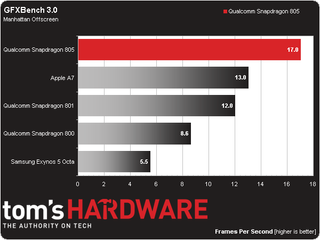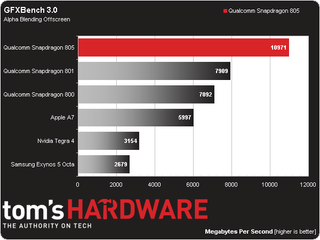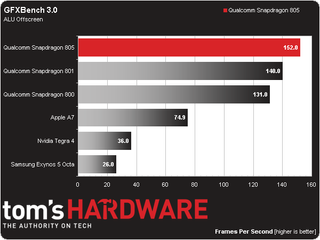Qualcomm Snapdragon 805 Performance Preview
The Snapdragon brand is synonymous with performance. It creates anxiety that competing SoCs feel deep down in their silicon substrate. But can Qualcomm's new Snapdragon 805 maintain its dominance in the Android-based smartphone market?
Results: GPU Core Benchmarks
For our GPU-based benchmarks, we are only looking at off-screen rendering performance to remove the influence of screen resolution on the results. This allows us to directly compare SoC performance, rather than overall product performance.
3DMark (Anti-Detection)
Futuremark has become a name synonymous with benchmarking, and the company's latest iteration of 3DMark offers three main graphical benchmarks: Ice Storm, Cloud Gate, and Fire Strike. Currently, the DirectX 9-level Ice Storm tests are cross-platform for Windows, Windows RT, Android, and iOS.
Ice Storm simulates the demands of OpenGL ES 2.0 games using shaders, particles, and physics via the company's in-house engine. Although it was just released in May of last year, the on-screen portions of Ice Storm have already been outpaced by modern mobile chipsets. Nvidia's Tegra 4 and Qualcomm's Snapdragon 800 both easily max-out the Extreme version (1080p with high-quality textures). Ice Storm Unlimited, however, renders the scene off-screen at 720p and is still a good gauge of GPU-to-GPU performance.
The Adreno 420 in Snapdragon 805 demonstrates a mere 6% advantage over the 801's Adreno 330 and a more impressive 29% advantage over the 800's lower-clocked Adreno 330.
Compared to Apple’s dual-core A7 SoC, Qualcomm's quad-core Krait 450 extends the company's already-impressive lead in the threaded Physics test. Isolating rendering performance in the two graphics sub-tests, however, reveals a much smaller margin of victory. It's only 3% in the Graphics Score test and 7% in Graphics Test 2.
Basemark X 1.1
Based on the Unity 4.0 game engine, Rightware’s Basemark X is a cross-platform graphics benchmark for Android, iOS, and Windows Phone 8. This test utilizes Unity’s modern features via the OpenGL ES 2.0 render path. Features like high poly count models, shaders with normal maps, complex LoD algorithms, and extensive per-pixel lighting (including directional and point light), along with a comprehensive set of post process, particle systems, and physics effects, test how a modern game might look and run. Basemark X is aggressive in that it still hasn't been maxed-out by the latest mobile SoCs.
The Adreno 420 engine shows off a more significant victory over its predecessor in this benchmark. Snapdragon 805 manages a 31% improvement over the 801 and a staggering 64% over the 800. These are the kind of gains we like to see from a new architecture. With future driver optimization, we could potentially see the 805 pull even further ahead.
Stay on the Cutting Edge
Join the experts who read Tom's Hardware for the inside track on enthusiast PC tech news — and have for over 25 years. We'll send breaking news and in-depth reviews of CPUs, GPUs, AI, maker hardware and more straight to your inbox.
In the High Quality test, the 805 outpaces both the 800/801 by about 60%. It also establishes a 37% advantage over the A7.
GFXBench 3.0
Kishonti GFXBench 3.0 is a cross-platform GPU benchmark supporting both the OpenGL ES 2.0 and OpenGL ES 3.0 APIs. It comprises both “high-level” game-like scenarios, along with more “low-level” tests designed to measure specific subsystems.
Among the high-level tests are Manhattan and T-Rex. Manhattan is a modern, complex OpenGL ES 3.0-based scenario, while the OpenGL ES 2.0-level T-Rex is a holdover from GFXBench v2.7.
The low-level workloads include Fill, which measures fill rate by rendering four layers of compressed textures; Alpha Blending, a test that renders layers of semi-transparent quads using high-resolution, uncompressed textures; ALU, for measuring shader compute performance; and Driver Overhead, which measures the CPU overhead of the graphics driver and API by making a lot of draw calls and state changes.
See GFXBench 3.0: A Fresh Look At Mobile Benchmarking for a complete test-by-test breakdown of this benchmark.

It’s exciting to see Snapdragon 805 blow past both the 801 and the A7. Qualcomm's Adreno 420 also earns the honor of being the first mobile GPU able to run T-Rex at 1080p with playable frame rates.

In the more complex OpenGL ES 3.0-based Manhattan test, Snapdragon 805 yields an impressive 42% advantage over the 801 and 31% lead over the A7. This result suggests that modern gaming titles should enjoy a significant performance boost from the Adreno 420.

The Fill test conveys the full effect of the 805’s extra memory bandwidth, pulling textures from main memory and then writing finished pixels back to the video buffer. Qualcomm's Snapdragon 805 achieves more than twice the performance of the 801! I speculated that the company added some additional TMUs to better-utilize its more potent memory controller and texture cache back in the GPU section; I believe this chart confirms it.

The Snapdragon 805 again shows its texture mapping prowess, with an almost-40% gain in throughput over the 801.

Snapdragon 805’s advantage is less than 10% over the 801 in this shader compute performance test.

The 805 does no worse than the other Snapdragons when we isolate Driver Overhead, but it’s still the lowest-performing SoC family in this benchmark.
Current page: Results: GPU Core Benchmarks
Prev Page Results: Web Benchmarks Next Page Results: GPGPU Benchmarks-
blackmagnum Trying not to be an Apple fanboy, but their A7 processor supports 64-bit instructions since last year. They lead innovation due to their clientele having more open-ended budget for the device than Android users (can't remember link to the study).Reply -
JOSHSKORN Did I read that right? There won't be ANY 64-bit Android Phones until 2015? It's going to take practically TWO YEARS to play catch-up to the iPhone? Mind you, most iPhone users don't know the difference between 32-bit and 64-bit, anyway, but it's "better" and that their logic for upgrading. Preying on stupid people basically has become (or always has been?) Apple's business model, and it's paid off. Sometimes, I wish I wasn't anti-Apple. C'mon, Android...get with the program!Reply -
rantoc Just find it funny tragic that more and more phone displays are almost at the same resolution as in many general desktop PC's.Reply
Also find it funny that their marketing team dare to call this "Ultra HD", would be fun to see a benchmark of this running that 4k resolution in any 3D descent detail benchmark=P
"It actually approaches what a fairly modern desktop CPU's integrated memory controller can do. All of this extra memory bandwidth isn’t for the CPU, though. It's reserved for Qualcomm’s new Adreno 420 GPU."
Yeah mostly is for the GPU, where a modern PC gpu alone pushes well over 300gb/sec. Close no? =P -
Memnarchon Dam! And I was hoping to see K1 on these benchmarks too, for a comparison. Oh well...Reply -
ta152h Is it too difficult for you guys to write a consistently good and accurate article? It's like you do the hard stuff, and then screw up details.Reply
For example, why are some charts from 0 to somewhere above the max score, and others start at, for example, 2300 and go to 3000.
I realize you guys aren't really computer people from this terrible lack of attention to detail (which someone who does more than write about computers has to have as a personality flaw), but can't you hire someone that can look over this stuff, and at least try to present it in a consistent way? Writers who aren't computer people make these types of mistakes, because their minds aren't ordered enough, but you guys really need someone like that, because all the articles suffer from imprecision and lack of clarity (and over use of words like 'alacrity', which really implies emotion, and isn't a true synonym for speed. Again, precision ...)
For example, I'm looking at charts, and am shocked by some, then realize it's just because you guys screwed up the scaling, and can't stay consistent.
Don't worry, a chart that shows very little difference because you used the full scale isn't bad. Because, if you really think about it, neither is the performance, and if you can't see a big difference in the chart, you aren't going to see a big difference in the performance. But, when you see one bar over three times longer than another, and the real difference is less than 20%, don't you think that gives the wrong impression?
If you do all the hard work, and then screw up details, it's just not as good as it could be. And yes, I've learned these sites like to say things in a way it is correct, but then present it in a manner which gives the opposite impression. Try writing without bias, and maybe this will go away. Charts are one way, comparing Kabinis with Haswells are another. Commenting more on charts that read what you want, while just presenting charts you don't like the results of, are another way. Or commenting on the part of the chart you like, while ignoring the part you don't. It's not as subtle as you might think, or maybe it is, and you don't even realize your bias. But we do.
I used to love this site, especially when Thomas Pabst used to write in his crazy way. But, it's slowly, and inexorably getting worse. There are better sites now. Maybe skip the really bad car reviews (do you really think your opinions even approximate professional sites like Car and Driver? At all? ) and focus more producing better quality computer articles. It should be easy, you guys get a lot of good information, often do reviews that people want but other sites skip, but then screw it up with a lack of attention to detail and consistency.
-
esrever I find the inconsistency makes most of this completely pointless until the software gets actually optimized and the drivers start working.Reply -
hannibal Well I really expect new article in near future where Tegra K1 and 805 are against each other. And then 810. It is interesting to see what 64bit computing will bring to mobile platforms... Mobile gaming is getting quite serious in next few years!Reply
-
irish_adam I dont see why you are all so impressed with 64bit. I mean if you believe that the A7 is super amazing because it is 64bit then you're an idiot. The fact that its 64bit adds minimal performance and is 100% gimmick and just so that they can claim to be the first.Reply
It reminds me of when AMD released their first 64bit chips and microsoft released XP64, you soon realised that unless you had 4gb or more of ram then there was no difference (well except that none of your hardware drivers would work grrrr).
Why would Qualcomm rush out a 64bit chip when there isnt any real improvement to be had? surely its better that they focus on things that will actually improve performance and battery life? I mean they havent even finished a 64bit version of android yet so what would it even run on? Until we see the need for more than 4gb of ram on phones then i really dont see the point
Most Popular


